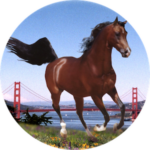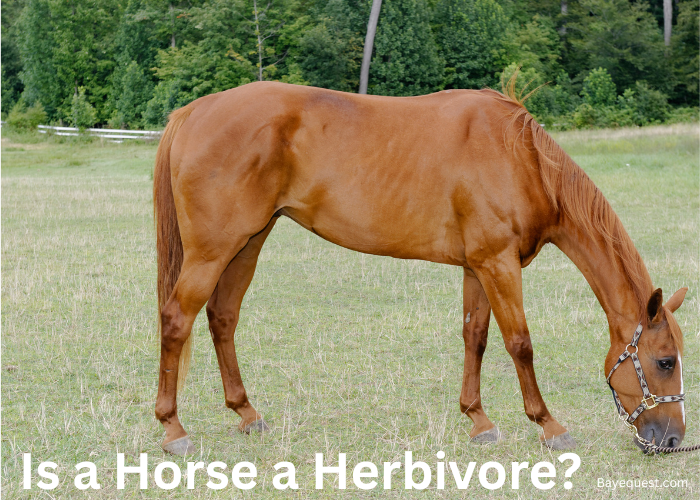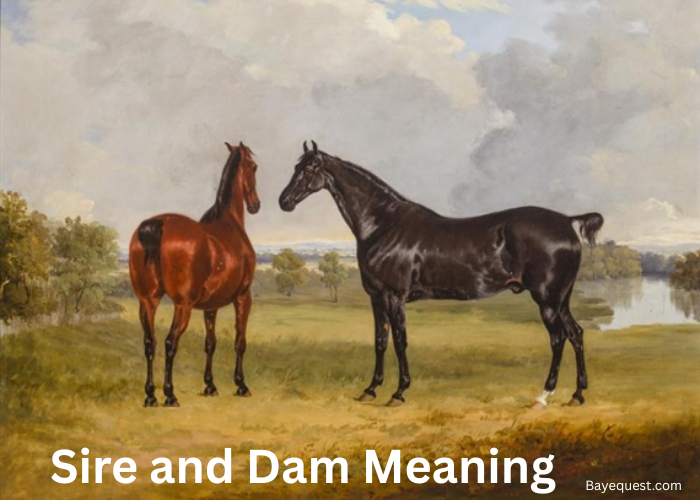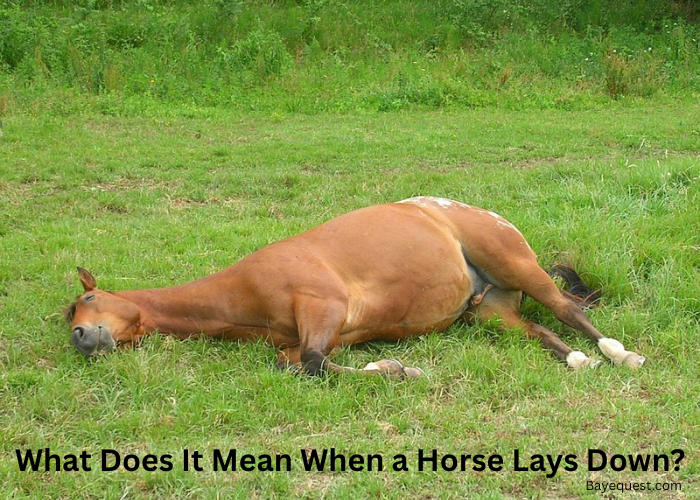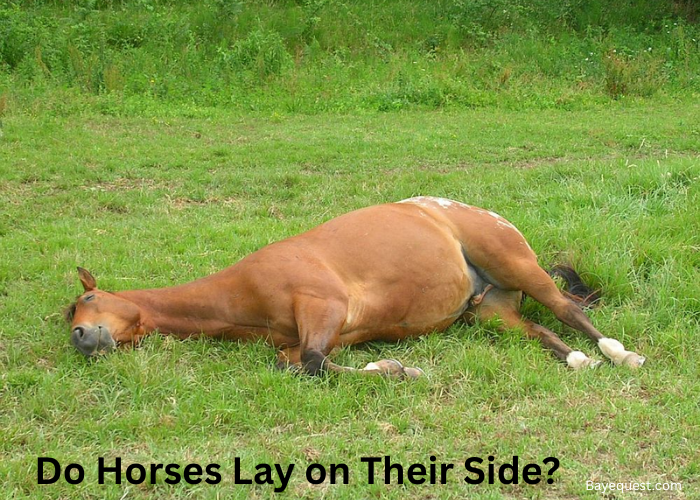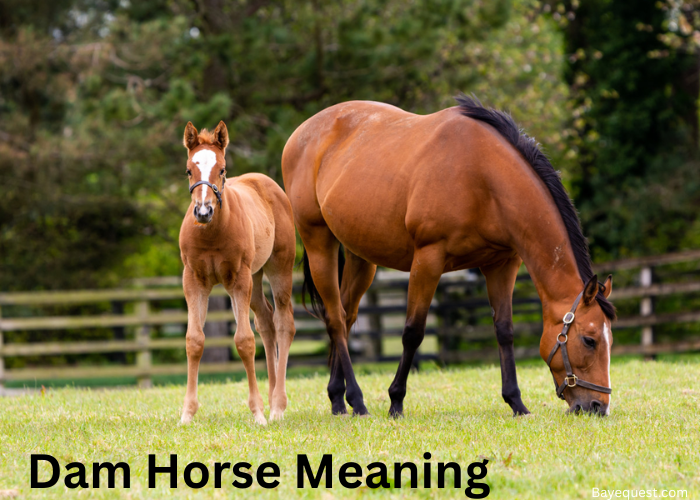Some animals eat meat, others stick to plants. So, where does the horse fit in?
You’ve probably seen horses munching on grass or hay. But does that make them true herbivores? And what exactly does being a herbivore mean?
In this blog, we’ll look at what horses eat, how their bodies digest food, and why their diet matters.
We’ll also clear up some common myths, like whether a horse can safely eat meat.
If you’ve ever wondered about a horse’s natural diet, this guide will give you the facts. Let’s break it down.
Is a Horse a Herbivore? Key Takeaway
Yes, horses are herbivores with a digestive system built for fiber-rich foods. They rely on constant grazing to keep their gut healthy and active. Feeding them grass, hay, and other plant materials supports digestion, while large or infrequent meals can upset their sensitive system and lead to health issues.
What is a Herbivore?
A herbivore is an animal that eats only plants. This includes grasses, leaves, stems, fruits, seeds, and roots.
Herbivores do not eat meat or animal products as part of their natural diet.
Some well-known herbivores include cows, goats, elephants, and deer. These animals have bodies that are built for chewing and digesting plants.
Their teeth are flat and wide for grinding food. Their digestive systems are slow but effective, allowing them to break down tough fibers like cellulose.
There are different types of herbivores.
Some, like cows and sheep, are called ruminants. They have stomachs with more than one compartment to help digest food.
Others, like horses and rabbits, are non-ruminant herbivores. They use a part of their gut called the cecum to ferment and digest plant matter.
Herbivores play an important role in nature. They help control plant growth and are a food source for carnivores.
Most importantly, their diets shape how their bodies, teeth, and digestive systems have evolved.
Anatomy of a Horse’s Digestive System
A horse’s digestive system is specially designed to handle a plant-based diet. From start to finish, each part plays a role in breaking down fibrous foods like grass and hay.
Here’s a breakdown of how it all works and why this system makes horses true herbivores.
Mouth and teeth
Digestion begins in the mouth. Horses have strong, flat teeth that are made for grinding.
The front teeth (incisors) cut grass, while the back teeth (molars and premolars) crush and grind it thoroughly.
As the horse chews, it produces a lot of saliva, up to 10 gallons per day. This saliva contains enzymes, including amylase, which begins breaking down carbohydrates right away.
The chewing motion also helps wear down the teeth, which continue to erupt throughout most of the horse’s life.
Fun fact: Horse teeth don’t stop growing in the traditional sense. They erupt slowly over the years to compensate for wear.
Esophagus
Once the food is chewed and moistened, it travels down the esophagus, a muscular tube about 4 to 5 feet long.
It moves food in one direction only. That means horses cannot vomit, which makes blockages and digestive issues especially risky.
Stomach
The horse’s stomach is surprisingly small, holding only about 8–10 liters of content. It makes up just 10% of the total digestive tract.
Because of this, horses are meant to eat small amounts over long periods, not two or three big meals like humans.
The stomach mixes food with acid and enzymes to start breaking down proteins.
But food doesn’t stay here long, so the horse needs to continue eating regularly to avoid ulcers or discomfort.
Small intestine
Next comes the small intestine, stretching up to 70 feet long. This is where most nutrient absorption happens.
Enzymes from the pancreas and bile from the liver help digest fats, proteins, and starches.
Important nutrients like amino acids, sugars, and vitamins are absorbed into the bloodstream through the intestinal walls.
Since digestion in this section is quick, poor chewing or overfeeding can result in undigested feed reaching the next stage.
Cecum and large colon
After the small intestine, food enters the cecum, a fermentation chamber around 4 feet long and holding up to 30 liters.
Here, billions of microbes break down cellulose from plant fibers into volatile fatty acids, which the horse uses for energy.
The partially digested material then moves into the large colon, where fermentation continues and water is absorbed.
If this microbial balance is disrupted, it can lead to colic or laminitis.
Small colon and rectum
The small colon pulls out the remaining water and starts forming solid waste. By the time food reaches the rectum, it’s been fully digested and is ready to be expelled as manure.
This final stretch ensures waste is compact and dry, which is why healthy horse droppings appear in firm, round balls.
What is the Natural Diet of Horses?
Horses are natural grazers. In the wild, they spend most of their day eating grasses and other low-growing plants.
Their diet includes fresh grass, herbs, leaves, and sometimes the bark of trees or shrubs. This high-fiber diet gives them the energy they need while keeping their digestive systems working smoothly.
Domestic horses eat a similar diet. The most common feed is hay, which is dried grass.
They may also get grains like oats or corn, especially if they need more energy. Some horses are given supplements or pellets to balance their nutrition.
Horses eat small amounts throughout the day. Their stomachs are small, so they’re not built for big meals.
Instead, they eat slowly and often. That’s why access to pasture or regular hay feeding is so important.
Overall, a horse’s natural diet is entirely plant-based. It’s rich in fiber, low in fat, and suited to constant grazing.
Feeding them anything else can lead to serious health issues.
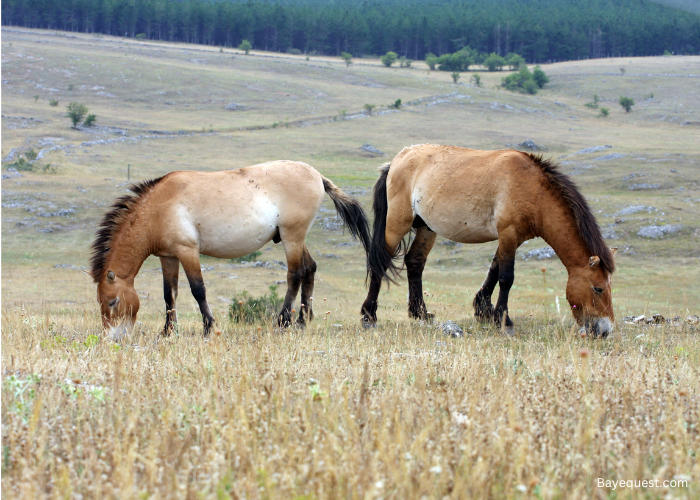
Can Horses Eat Meat and What Happens if They Do?
Horses are herbivores by nature. Their digestive systems are built to process plants, not meat.
But occasionally, you might hear about a horse nibbling on a burger or licking a salty piece of ham. So what’s going on?
In rare cases, horses may show curiosity and taste non-plant items. This is usually due to a salt craving or boredom, not a desire for meat.
Just because a horse bites something doesn’t mean it’s part of their diet.
That said, feeding meat to a horse is never a good idea. Their stomach lacks the enzymes needed to digest animal protein and fat properly.
Read also: Is Horse Meat Halal?
Health Risks Associated with Horses Eating Meat
Horses are obligate herbivores, meaning their bodies are built to digest plants. Here’s a closer look at the potential dangers of feeding them meat.
1. Gut disruption and microbial Imbalance
The horse’s hindgut depends on a stable population of fiber-digesting microbes. These microbes ferment roughage and produce essential nutrients like volatile fatty acids.
Meat introduces proteins and fats that the gut microbes aren’t equipped to handle. This disruption can kill off beneficial bacteria, leading to poor digestion, gas buildup, and even toxic conditions.
2. Increased risk of colic
Colic is a general term for abdominal pain in horses and can be fatal. Sudden diet changes, especially introducing meat, can upset gut motility and microbial balance.
This can result in blockages, gas accumulation, or impaction, all of which are common forms of colic triggered by improper feeding.
3. Liver and kidney strain
Horses are not adapted to process high levels of dietary protein from meat.
The excess nitrogen and byproducts from animal protein put pressure on the liver and kidneys, which must work overtime to filter them out.
Over time, this strain can lead to organ damage or failure.
4. Risk of foodborne illness
Unlike carnivores, horses lack the stomach acid levels needed to kill harmful bacteria found in raw or spoiled meat.
This puts them at higher risk of food poisoning from pathogens like Salmonella or E. coli, which can result in fever, diarrhea, and dehydration.
5. Digestive intolerance and discomfort
Even small amounts of meat can cause discomfort. Horses may show signs of mild colic, bloating, loose stool, or simply go off their feed.
Their digestive enzymes aren’t suited for breaking down fat and animal tissue, so meat often passes undigested or causes irritation.
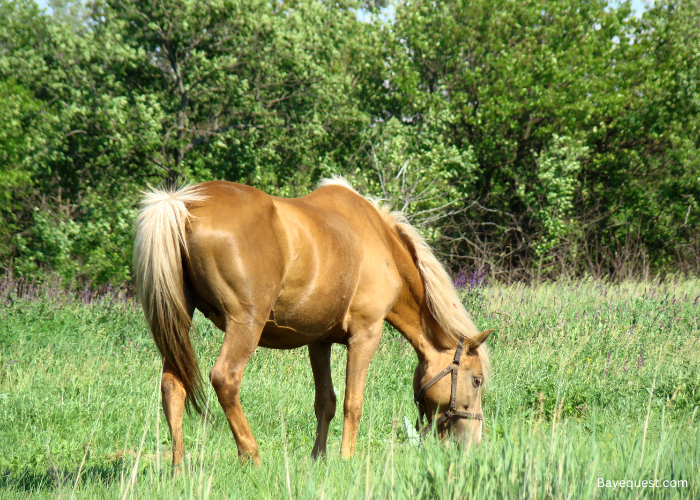
What To Feed a Horse Instead of Meat
Since horses are strict herbivores, they should focus on fiber-rich, plant-based foods that support healthy digestion, energy, and overall well-being. Here’s what you should feed a horse instead of meat:
1. Fresh grass
Grazing on pasture is the most natural and balanced diet for a horse. It provides fiber, hydration, and nutrients in their most natural form.
Make sure the pasture is free from toxic plants.
2. Hay (Grass or legume)
When fresh grass isn’t available, hay is the next best option. Timothy, Bermuda, or orchard grass hays are excellent choices.
You can also give them Alfalfa hay in moderation, especially to growing or working horses needing more protein and calcium.
3. Commercial horse feed or pellets
Formulated feeds are designed to provide balanced nutrition, including vitamins and minerals.
Choose high-fiber options for maintenance or senior horses, and higher-energy blends for performance horses.
4. Grains (In moderation)
Oats, corn, and barley can add energy to a horse’s diet, especially for those in training.
However, too much grain can lead to digestive issues, so always feed in controlled amounts.
5. Fresh fruits and vegetables (Safe options only)
Treat your horse to apples, carrots, bananas, watermelon (without seeds), and pumpkin. These add variety and nutrition but should only be offered in small amounts.
Read more on the foods horses can or cannot eat in this post.
6. Salt and mineral blocks
Horses need access to salt and essential minerals.
A plain salt block or a mineralized one helps maintain electrolyte balance, especially in hot weather or after exercise.
7. Chaff and beet pulp
Chopped hay (chaff) and soaked beet pulp are excellent fiber sources, especially for older horses or those with dental issues. Beet pulp is low in sugar and high in digestible fiber.
FAQs
Can horses eat meat?
Horses are natural herbivores with digestive systems designed for plant-based diets. Feeding them meat can upset their gut, cause colic, and lead to serious health issues. While they may nibble out of curiosity, meat offers no nutritional benefit and should never be part of a horse’s regular diet.
Read more here: Can Horses Eat Meat?
What happens if a horse eats something it shouldn’t?
If a horse eats something it shouldn’t, it may develop symptoms such as colic, diarrhea, bloating, or loss of appetite. In severe cases, it can lead to poisoning or life-threatening digestive problems.
Conclusion
Horses are herbivores. Their teeth, stomach, and gut are all built for eating plants.
Grass, hay, and other fibrous foods give them the energy and nutrients they need. Feeding meat to horses can cause serious health problems.
It goes against how their bodies are meant to work.
Even if a horse nibbles something unusual, it doesn’t mean it’s safe. Stick to natural, plant-based feeds to keep your horse healthy and strong.
When in doubt, always choose what nature intended for them.
